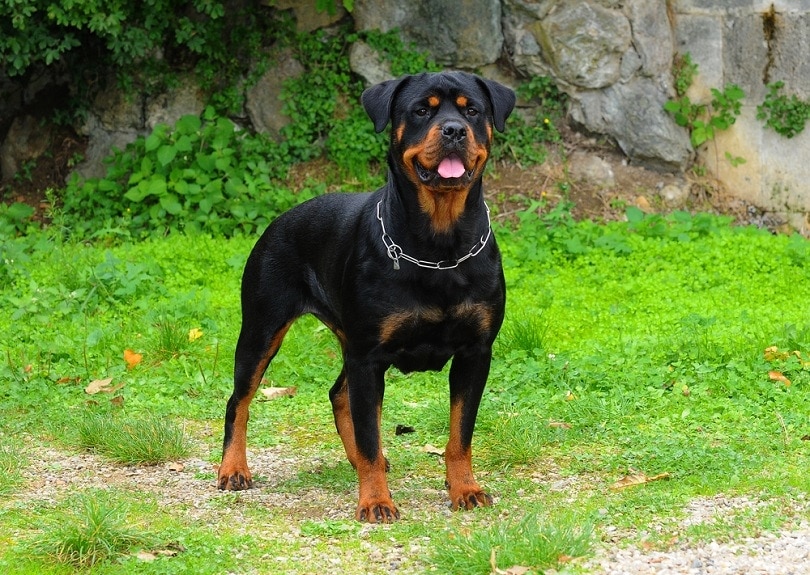14 Dog Breeds Prone to Arthritis (Vet Answer)

Updated on

Arthritis is one of the most common joint disorders that your dog can suffer from. The term comes from the Greek words “arthro,” meaning “joint,” and “itis,” meaning inflammation, so it’s inflammation of the joints. With arthritis, the cartilage and fluids that normally work as a cushion to protect the bones from impact against each other deteriorate, becoming progressively thinner. Once cartilage wears away, it can never be restored. Therefore, this condition is accompanied by acute pain, swelling of the joints, stiffness, difficulty getting up or lying down, and lameness. As the disease progresses and becomes chronic, the degree of inflexibility of the affected dogs increases, and ankylosis (stiffness, immobility) may occur.
In most cases, it is a progressive degenerative disease that worsens with age. The effects of arthritis can directly affect your dog’s quality of life because it causes acute pain and discomfort. The condition can be kept under control if it is diagnosed and treated in time, but it cannot be cured.
Here are the most common dog breeds that can suffer from arthritis.
The 14 Dog Breeds That Are Prone to Arthritis
1. Labrador Retriever

Labradors are among the most popular dog breeds. They are intelligent, sociable, and loving dogs, being the favorite companions of families all over the world. Labs are easily adaptable and have an average life expectancy of 10–13 years. However, there are several diseases frequently encountered in this breed—some inherited, others acquired during life—and arthritis is among them. They are a large and active breed that likes to engage in intense physical activities that put pressure on the joints, which leads to wear and tear over time. To reduce the chances that your dog will develop arthritis, it is recommended to keep them at an ideal weight.
2. Golden Retriever

The Golden Retriever has a high risk of developing arthritis. This intelligent and sociable breed likes intense physical activity and is prone to gaining weight, so it is recommended to keep their weight under control to reduce the risk of arthritis.
3. English Springer Spaniel

The English Springer Spaniel is a medium-sized hunting dog originally from Great Britain. This friendly and intelligent dog likes petting, playing, and physical activity, having a high level of energy. Their average lifespan is 12–14 years. Being a breed prone to arthritis and other bone diseases, it is recommended to keep their weight under control and alter long walks and intense play sessions to shorter, more frequent walks and shorter play sessions.
4. German Shepherd

The German Shepherd is a hardworking and focused breed that is not always friendly with strangers but is very loving with family members. Being intelligent, they are often used as working dogs.
This large breed is susceptible to developing osteoarthritis. Their average lifespan is 12–14 years.
5. Rottweiler

The Rottweiler is a large breed prone to developing osteoarthritis due to their size. They are muscular, loving, obedient, and intelligent dogs. They have a strong desire to be in control, making great use of their ability to intimidate. Their lifespan is 8–10 years.
6. Bernese Mountain Dog

The Bernese Mountain Dog is an extremely adaptable and hardworking animal that comes from the farm areas of Switzerland. Intelligent, strong, agile, calm, and confident, the Bernese Mountain dog is a versatile working dog. The life expectancy of this breed is 6–8 years. Being a large breed, they are prone to developing arthritis.
7. Samoyed

Samoyed is a breed originating from Siberia, their ancestors being domesticated more than 3,000 years ago and used mainly for driving herds of animals, pulling sleds, and hunting. The name of the breed comes from the name of a Siberian tribe, Samoyed, whose members (the Samoyedic people) used them intensively for specific activities. This large and energetic breed is prone to arthritis and has an average lifespan of 12–14 years.
8. St. Bernard

The St. Bernard is one of the largest and heaviest dog breeds in the world. While once working dogs, nowadays, these gentle giants are especially popular with families. They can be territorial and alert, and some representatives of the breed also have a protective instinct. These characteristics make the St. Bernard a reliable guard dog.
This giant dog’s joints carry an extra large load, making them more prone to osteoarthritis than other breeds. Their lifespan is 8–10 years.
9. Pit Bull

Pit Bulls have short fur, well-defined muscles, a wide neck and chest, and a flat head, all of which give them the appearance of being strong and agile. In almost all cases, these are obedient dogs that are willing to serve their owners, which means they have strong protective instincts and are capable of fighting to the death to defend their families or property. Although they are medium sized, they are prone to arthritis. It usually occurs secondary to other degenerative conditions, such as hip or elbow dysplasia. Their lifespan is 8–15 years.
10. Bulldog

The Bulldog is a medium-sized dog with a strong, muscular, and heavy body. They have short legs, a broad and muscular chest, and a massive and square head. This breed can develop secondary arthritis as a result of pre-existing joint conditions like hip dysplasia, joint trauma, or patellar dislocation. Bulldogs can live up to 10 years or more in some cases.
11. Great Dane

The Great Dane is known as the tallest dog breed in the world. This strong and fast animal loves events that involve running or chasing.
They are excellent guard dogs, as they are loyal, balanced, and calm. Great Danes are receptive and loving, especially with children, but can become suspicious of strangers. However, being a giant breed, they are prone to arthritis. Great Danes have a lifespan of 8–10 years.
12. Old English Sheep Dog

Also known as the Bobtail dog, the Old English Sheepdog is on of the oldest dog breeds in England. They are active, intelligent, cheerful, and friendly. They adapt relatively easily to the needs of the family, being tolerant of children and other animals.
This is not a noisy dog, and they are primarily devoted to their owner. Being a giant breed, they are prone to developing osteoarthritis secondary to hip dysplasia. This breed can live up to 12 years in some cases.
13. Dachshund

These small yet long dogs are good watchdogs. They are playful and loving with their family and can be suspicious of strangers. The energy levels of this breed are normal, meaning they are not hyperactive. Having a long spine, though, they are more prone to developing arthritis. They also have short legs and carry a great deal of weight on them, which puts extra pressure on their joints. Being a small breed, they can live up to 16 years.
14. Mastiff

Mastiffs are independent and strong-willed, making them good guard dogs. They have a bad reputation due to their massive size, but these are gentle pups. Being a giant breed, they are prone to hip dysplasia, which can lead to arthritis. The lifespan of Mastiffs is 7–10 years.
How Is Arthritis Treated?
Once the vet has diagnosed your dog with arthritis, action must be taken as soon as possible. The treatments will not cure arthritis but can improve its clinical signs and slow its progress, so your dog can lead a life with less pain. Your veterinarian will likely recommend anti-inflammatory drugs (chewable tablets, oral tablets, or injectables) for your dog, along with joint supplements.
In addition to the treatment prescribed by the veterinarian, you can help your dog by providing gentle physical exercise and adequate nutrition, ensuring that they stay at a healthy weight. Swimming is a great exercise option for these dogs, especially if the water is not cold. You can also try laser therapy.
Conclusion
Arthritis is a progressive degenerative disease that leads to joint stiffness, acute pain, lameness, and difficulties in getting up or lying down. Some breeds are more predisposed to develop arthritis than others, but any dog can develop this condition at some point in their life. It cannot be treated, but the pain and inflammation can be reduced with medication. You can also try changing your pet’s diet and taking your dog to a few laser therapy sessions, which can help reduce pain and inflammation of the joints.
Featured Image Credit: DanaTentis, Pixabay














